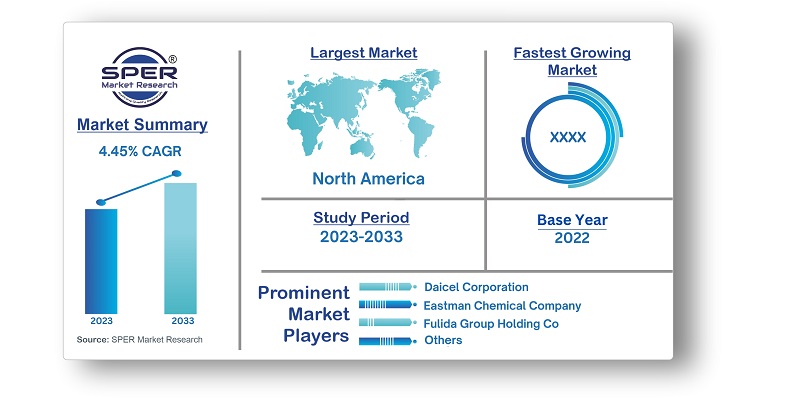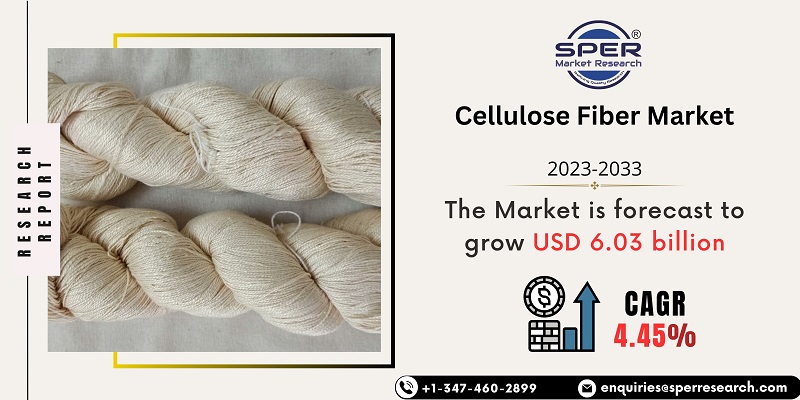
Cellulose Fiber Market Growth, Trends, Size, Revenue, Demand, Competition and Future Challenges
Cellulose Fiber Market Size- By Fiber Type, By Application- Regional Outlook, Competitive Strategies and Segment Forecast to 2033
| Published: Feb-2020 | Report ID: CHEM2005 | Pages: 1 - 214 | Formats*: |
| Category : Chemical & Materials | |||
- In 2021, a US-based company called Bacterial Cellulose Solution introduced a wound healing product based on bacterial cellulose. This innovative substance acts as a natural barrier against bacterial infiltration while maintaining a moist and warm environment on the skin surface. By doing so, it helps alleviate pain and prevents infection in incisions. The solution offered by Bacterial Cellulose can be tailored to meet customer requirements in terms of thickness, opacity, texture, and mechanical properties.
- In 2022, Sappi made a commitment to actively contribute to addressing climate change by decarbonizing its operations. As part of its long-term global commitment to sustainable production and climate preservation, the company has decided to discontinue the use of coal at its Stockstadt location in Germany. In line with this commitment, Sappi plans to dismantle the existing coal-fired Boiler 9 at the mill and transition to running the facility entirely on renewable biomass and natural gas. This step underscores Sappi's dedication to reducing its carbon footprint and embracing more sustainable energy sources.


| Report Metric | Details |
| Market size available for years | 2019-2033 |
| Base year considered | 2022 |
| Forecast period | 2023-2033 |
| Segments covered | By Fiber Type, By Application |
| Regions covered | Asia Pacific, Europe, Middle East and Africa, North America, Latin America |
| Companies Covered | Daicel Corporation, Eastman Chemical Company, Fulida Group Holding Co., Ltd, Grasim Industries Ltd. (Aditya Birla Group), International Paper Company, Kelheim Fibres GmbH, Lenzing AG, Sappi Limited, Sateri, Tangshan Sanyou Group Xingda Chemical Fibre Co.Ltd, Others |
- Agricultural and Horticultural Industry
- Automotive and Transportation Industry
- Construction Industry
- Environmental and Sustainability Initiatives
- Home and Furniture Industry
- Nonwovens Industry
- Paper and Packaging Industry
- Personal Care and Hygiene Industry
- Textile and Apparel Industry
- Others
| By Fiber Type : |
|
| By Application : |
|
- Global Cellulose Fiber Market Size (FY’2023-FY’2033)
- Overview of Global Cellulose Fiber Market
- Segmentation of Global Cellulose Fiber Market By Fiber Type (Manufactured Cellulose Fibers, Natural Cellulose Fibers, Semi Synthetic Cellulose Fibers, Synthetic Cellulose Fibers)
- Segmentation of Global Cellulose Fiber Market By Application (Apparel, Home Textile, Industrial, Others)
- Statistical Snap of Global Cellulose Fiber Market
- Expansion Analysis of Global Cellulose Fiber Market
- Problems and Obstacles in Global Cellulose Fiber Market
- Competitive Landscape in the Global Cellulose Fiber Market
- Impact of COVID-19 and Demonetization on Global Cellulose Fiber Market
- Details on Current Investment in Global Cellulose Fiber Market
- Competitive Analysis of Global Cellulose Fiber Market
- Prominent Market Players in the Global Cellulose Fiber Market
- SWOT Analysis of Global Cellulose Fiber Market
- Global Cellulose Fiber Market Future Outlook and Projections (FY’2023-FY’2033)
- Recommendations from Analyst
1.1. Scope of the report1.2. Market segment analysis
2.1. Research data source2.1.1. Secondary Data2.1.2. Primary Data2.1.3. SPER’s internal database2.1.4. Premium insight from KOL’s2.2. Market size estimation2.2.1. Top-down and Bottom-up approach2.3. Data triangulation
4.1. Driver, Restraint, Opportunity and Challenges analysis4.1.1. Drivers4.1.2. Restraints4.1.3. Opportunities4.1.4. Challenges4.2. COVID-19 Impacts of the Global Cellulose Fiber Market
5.1. SWOT Analysis5.1.1. Strengths5.1.2. Weaknesses5.1.3. Opportunities5.1.4. Threats5.2. PESTEL Analysis5.2.1. Political Landscape5.2.2. Economic Landscape5.2.3. Social Landscape5.2.4. Technological Landscape5.2.5. Environmental Landscape5.2.6. Legal Landscape5.3. PORTER’s Five Forces5.3.1. Bargaining power of suppliers5.3.2. Bargaining power of buyers5.3.3. Threat of Substitute5.3.4. Threat of new entrant5.3.5. Competitive rivalry5.4. Heat Map Analysis
6.1. Global Cellulose Fiber Market Manufacturing Base Distribution, Sales Area, Product Type6.2. Mergers & Acquisitions, Partnerships, Product Launch, and Collaboration in Global Cellulose Fiber Market
7.1. Global Cellulose Fiber Market Value Share and Forecast, By Fiber Type, 2023-20337.2. Manufactured Cellulose Fibers7.3. Natural Cellulose Fibers7.3.1. Cotton7.3.2. Jute7.3.3. Others7.4. Semi Synthetic Cellulose Fibers7.4.1. Modal7.4.2. Viscose7.5. Synthetic Cellulose Fibers7.5.1. Nylon7.5.2. Polyester
8.1. Global Cellulose Fiber Market Value Share and Forecast, By Application, 2023-20338.2. Apparel8.3. Home Textile8.4. Industrial8.5. Others
9.1. Global Cellulose Fiber Market Size and Market Share
10.1. Global Cellulose Fiber Market Size and Market Share By Fiber Type (2019-2026)10.2. Global Cellulose Fiber Market Size and Market Share By Fiber Type (2027-2033)
11.1. Global Cellulose Fiber Market Size and Market Share By Application (2019-2026)11.2. Global Cellulose Fiber Market Size and Market Share By Application (2027-2033)
12.1. Global Cellulose Fiber Market Size and Market Share By Region (2019-2026)12.2. Global Cellulose Fiber Market Size and Market Share By Region (2027-2033)12.3. Asia-Pacific12.3.1. Australia12.3.2. China12.3.3. India12.3.4. Japan12.3.5. South Korea12.3.6. Rest of Asia-Pacific12.4. Europe12.4.1. France12.4.2. Germany12.4.3. Italy12.4.4. Spain12.4.5. United Kingdom12.4.6. Rest of Europe12.5. Middle East and Africa12.5.1. Kingdom of Saudi Arabia12.5.2. United Arab Emirates12.5.3. Rest of Middle East & Africa12.6. North America12.6.1. Canada12.6.2. Mexico12.6.3. United States12.7. Latin America12.7.1. Argentina12.7.2. Brazil12.7.3. Rest of Latin America
13.1. Daicel Corporation13.1.1. Company details13.1.2. Financial outlook13.1.3. Product summary13.1.4. Recent developments13.2. Eastman Chemical Company13.2.1. Company details13.2.2. Financial outlook13.2.3. Product summary13.2.4. Recent developments13.3. Fulida Group Holding Co., Ltd13.3.1. Company details13.3.2. Financial outlook13.3.3. Product summary13.3.4. Recent developments13.4. Grasim Industries Ltd. (Aditya Birla Group)13.4.1. Company details13.4.2. Financial outlook13.4.3. Product summary13.4.4. Recent developments13.5. International Paper Company13.5.1. Company details13.5.2. Financial outlook13.5.3. Product summary13.5.4. Recent developments13.6. Kelheim Fibres GmbH13.6.1. Company details13.6.2. Financial outlook13.6.3. Product summary13.6.4. Recent developments13.7. Lenzing AG13.7.1. Company details13.7.2. Financial outlook13.7.3. Product summary13.7.4. Recent developments13.8. Sappi Limited13.8.1. Company details13.8.2. Financial outlook13.8.3. Product summary13.8.4. Recent developments13.9. Sateri13.9.1. Company details13.9.2. Financial outlook13.9.3. Product summary13.9.4. Recent developments13.10. Tangshan Sanyou Group Xingda Chemical Fibre Co.Ltd13.10.1. Company details13.10.2. Financial outlook13.10.3. Product summary13.10.4. Recent developments13.11. Others
SPER Market Research’s methodology uses great emphasis on primary research to ensure that the market intelligence insights are up to date, reliable and accurate. Primary interviews are done with players involved in each phase of a supply chain to analyze the market forecasting. The secondary research method is used to help you fully understand how the future markets and the spending patterns look likes.
The report is based on in-depth qualitative and quantitative analysis of the Product Market. The quantitative analysis involves the application of various projection and sampling techniques. The qualitative analysis involves primary interviews, surveys, and vendor briefings. The data gathered as a result of these processes are validated through experts opinion. Our research methodology entails an ideal mixture of primary and secondary initiatives.



Frequently Asked Questions About This Report
PLACE AN ORDER
Year End Discount
Sample Report
Pre-Purchase Inquiry
NEED CUSTOMIZATION?
Request CustomizationCALL OR EMAIL US
100% Secure Payment






Related Reports
Our Global Clients
Our data-driven insights have influenced the strategy of 200+ reputed companies across the globe.






















